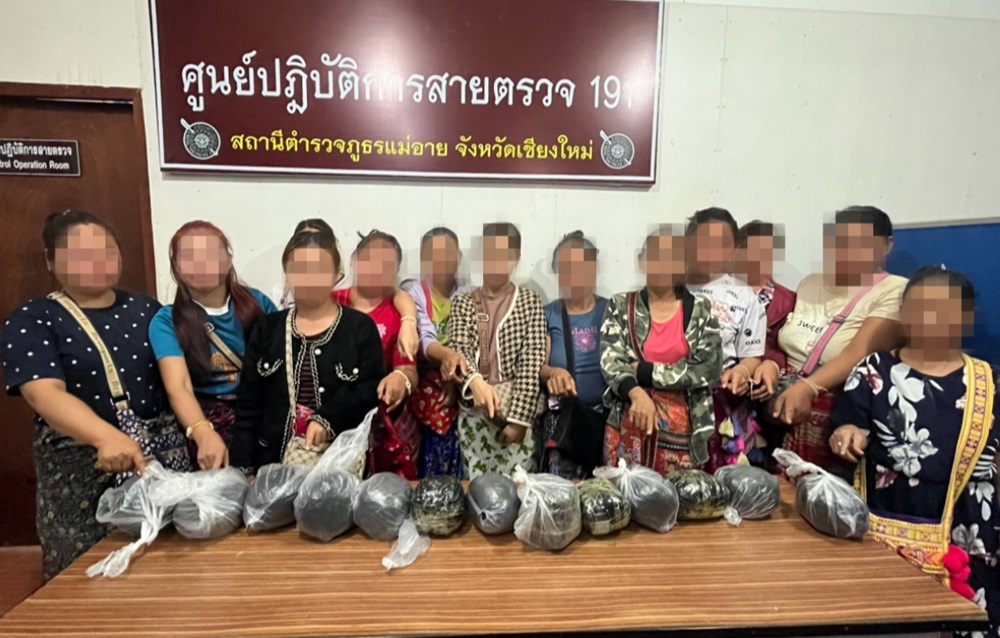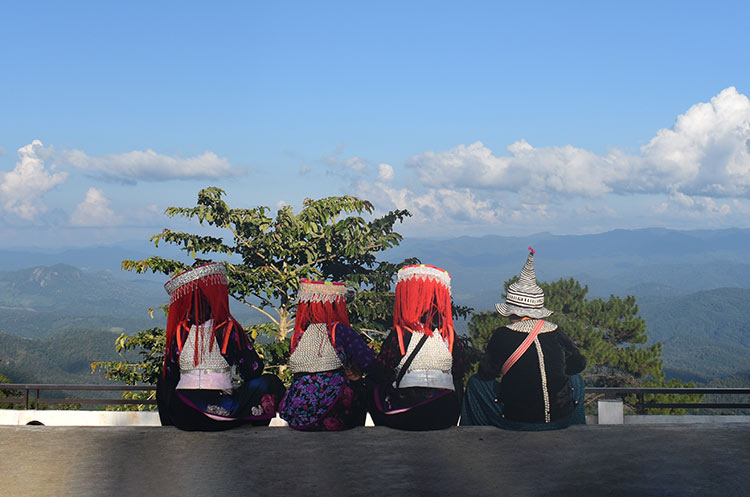On Sunday, police arrested thirteen hilltribe women in Chiang Mai province for allegedly carrying opium. Officers from the northern city’s Mae Ai district police station. Police detained a pickup truck leaving an alley near a nearby school after receiving a tip.
In the back of the pickup there were 13 hilltribe women who, according to authorities, acted suspiciously. They appeared pregnant, with bulging bellies. A female police officer’s body search revealed packs of raw opium stashed in their pants.
Each of the 13 women carried an opium bag weighing 1.64 kilogrammes. The 13 packs weighed 21.32 kilogrammes. The woman and the driver were both charged with possessing the second type of narcotic (opium) with the intent to sell.
According to police, the suspects confessed to obtaining the opium from a hilltribe village in Tha Tonne sub-district of Chiang Mai Province.
Opium is cultivated illegally by hilltribes in northern Thailand. The cultivation of opium by these hilltribes has been a longstanding practice. This illicit activity has attracted the attention of authorities due to its impact on the local community and the region.
The production and distribution of opium by these hilltribes have led to various social and economic issues that need to be addressed. The hilltribes involved in opium cultivation face challenges in transitioning to alternative sources of income.
Efforts are being made to provide support and resources to help these communities shift away from opium cultivation towards more sustainable livelihoods. The government is working to combat the production and distribution of opium in the region to address the associated issues effectively.
Hill Tribe people in Northern Thailand
Northern Thailand is well-known for its Hilltribe villages, which are a major draw for visitors interested in learning about and experiencing their culture and way of life. Just a few minutes outside Chiang Mai city, you’ll find yourself in villages where Thai is no longer the primary language and people look and dress differently, which is one of the many benefits of seeing this incredible region of the world.
Thailand currently has six major ethnic Hilltribe groups, as well as several minor tribes and subgroups, and the great majority of them work as farmers in the highlands. Life is not always simple for these ethnic groups, with many being classified as ‘outsiders’, denied full citizenship rights, and lacking full ownership rights to their land despite having lived in the region for hundreds of years or more. However, many Hill Tribe settlements share a genuine friendliness and openness to tourists, as well as the tough and stoic attitude that so many mountain people around the world possess.
Karen People
The Karen people in Northern Thailand, can be found throughout the north of Thailand and as far south as the mountains of Kaeng Krachan, all the way to Bangkok. Karen people are divided into four main subgroups: ‘White’, ‘Red’, ‘Pa-o’, and ‘Kayah’, each with their unique language, culture, and customs.
Karen settlements can be found all throughout Chiang Rai’s mountains, and while they used to conduct slash and burn agriculture, they are now in the forefront of developing more environmentally sustainable farming practices.
Karen villages are often very open to guests, eager to share their story and culture, and spending a night or two in a Karen community, sitting around the fire, sharing food and tales, and learning about life in the mountains, is an unforgettable Northern Thailand experience.
Many people identify Karen people with ‘long neck’ Paduang ladies. These women are Karen, however they represent only a small portion of the ethnic community. While many tourists want to visit a ‘long neck’ village, please treat the women with respect and not as zoo exhibits.
Akha
The Akha people are one of Thailand’s best-known Hill Tribes, with an estimated 70-80,000 people living in the mountains. The Akha traditional attire is highly vibrant, with great headpiece, and it is wonderful to see it worn in a small village high in the highlands.
Historically, the Akha people were primarily connected with opium cultivation in Northern Thailand, but with this practice mostly abolished, they have successfully shifted to farming a variety of commodities, including some of Thailand’s best coffee.
Lahu
The Lahu people are a fairly diversified group with numerous sub-groups and cultures spread across South East Asia’s mountainous regions. With approximately 60,000 Lahu people in Thailand, they primarily live in the higher highlands of Chiang Mai and Chiang Rai, generally in more rural communities away from roads and towns.
The Lahu are primarily subsistence farmers, but they are also noted for their hunting and warfare skills. The Lahu people adhere to stringent community standards, respect village elders, and maintain a high level of gender equality throughout the community.
Lisu
The Lisu people are originated from Tibet. Under pressure from the Chinese government and in search of land to let them to practise their culture freely, they went south to Myanmar and then into Thailand. The Lisu people venerate both their ancestors and spirits.
The Lisu people prefer to live in villages above 1,000 metres, and communities are frequently located near mountain summits or at the base of falls.
There are an estimated 50,000 Lisu people living in the highlands of Northern Thailand.
Hmong
The first Hmong people in Thailand were created in the early nineteenth century after they fled China due to strife with the Han Chinese, and they can now be found throughout much of northern Thailand. With numerous sub-groups, they were previously connected with opium farming, which has since been supplanted by other cash crops such as cabbage, potatoes, tomatoes, and strawberries.
There are extensive Hmong communities in Chiang Mai province, particularly above Wat Doi Suthep and around Doi Inthanon, Thailand’s highest peak.
Yao
The Yao people, like many other Hilltribe tribes, moved from China and arrived in Thailand in the early nineteenth century. They have settlements throughout the North, but are most prevalent in Chiang Rai province, where many fled persecution by the Pathet Lao dictatorship in the 1970s after supporting the US in the Laos civil war.
While the Yao people mainly adhere to the Buddhist way of life, they also incorporate old animist ideas into their practice of Buddhism.
There are approximately 40,000 Yao people in Thailand today, distributed among 200 or so small settlements.







